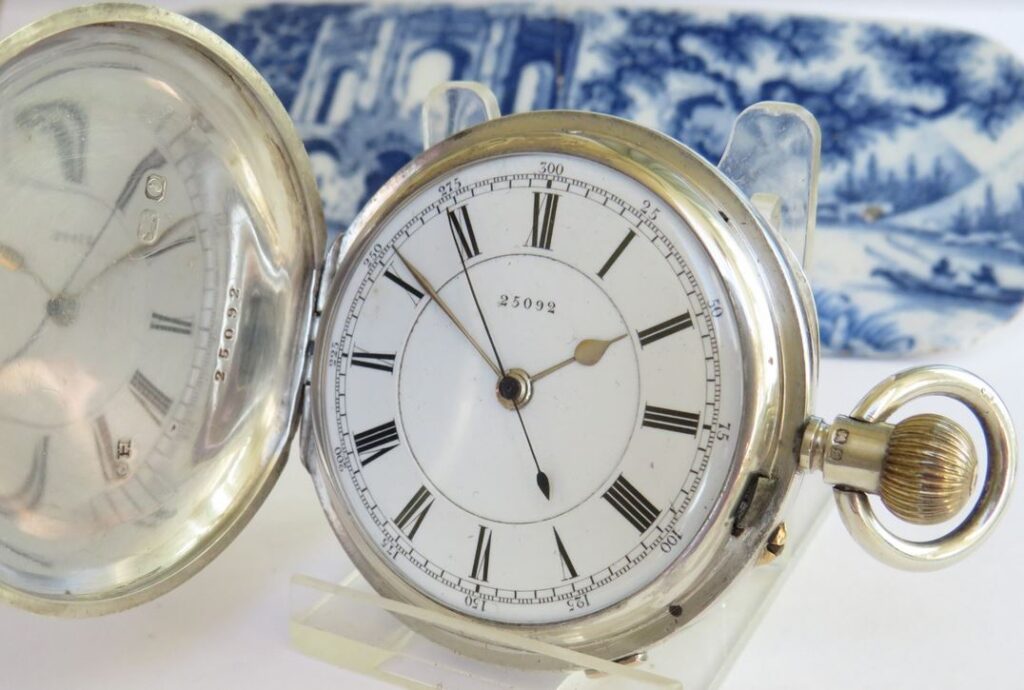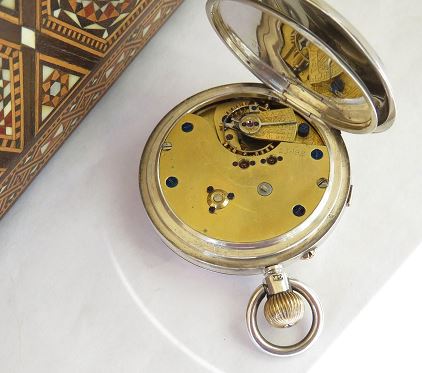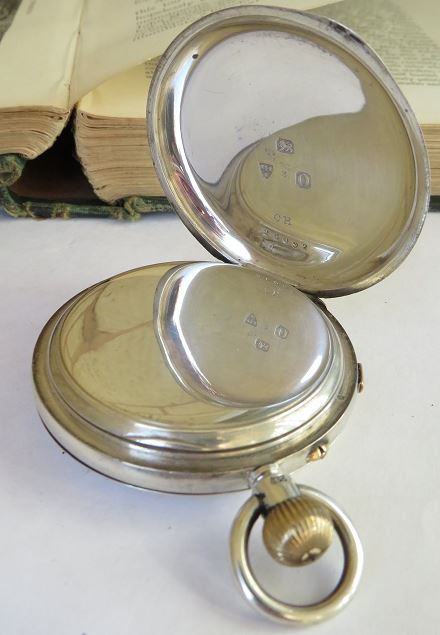Last updated on May 3, 2024
This is an interesting timepiece I uncovered on my search for my first hunter cased pocket watch. It’s a silver hunter chronograph with a centre second hand. A chronograph is a specific type of watch that is used as a stopwatch combined with a normal display watch. I have not even owned a modern mechanical chronograph, so this was something very different for me. Although I do admit, I own a G-Shock with a stopwatch function. I guess the one concern I might have is that if something goes wrong with a watch with such a complication it might be a nightmare to have repaired.

I found this particular one online, but I had seen one very similar in a local antique shop only a week or two ago. I didn’t buy it because it was an open-faced chronograph and I’m looking for an antique hunter case pocket watch. However, I did manage to have a long discussion with the proprietor about the watch. He was an antique dealer, not a watch specialist, but he knew what he was talking about and he asked me if I knew what the larger numbers on the very outer edge of the dial were (0 to 300). I had to admit I didn’t and he explained that it was a tool for artillery officers to determine the distance to the enemy guns. Intrigued, I decided to go home and research. As tempted as I was, I didn’t buy the watch as there was too little detail about the watchmaker.
How watches tick
I’ve done my research and it has been quite interesting. The first thing we need to understand is about a watch’s tick. In a mechanical watch movement with a balance wheel, one vibration is a single swing of the balance wheel. A vibration is one-half of an oscillation or a semi-oscillation. So, one swing of the balance wheel in either direction, for example clockwise, is one vibration or semi-oscillation, and two swings, for example clockwise then counter-clockwise, is an oscillation.
The frequency of a watch movement can be expressed in Hertz (Hz) or in vibrations per hour (vph), which is also sometimes referred to as A/h. The frequency in Hertz is the number of oscillations per second. Double the hertz figure to get the number of vibrations or semi-oscillations per second. Multiply that number by 3600 (the number of seconds in an hour) to get the vph.
The most common frequency for modern mechanical wristwatch movements is 4 Hz or 28,800 vph. A watch ticking at 4 Hz makes 4 oscillations per second or 8 semi-oscillations (or vibrations) per second. There are 60 seconds in a minute, so this watch would tick at 480 semi-oscillations (or vibrations) per minute. Multiplying the 480 vibrations per minute by the 60 minutes in an hour yields the 28,800 vph figure. Since this watch ticks 8 times per second, a chronograph in a 28,800 vph watch can time events to the nearest 1/8 of a second.
Measuring distance through time
Following this formula, a watch with a rate of 2.5 Hz or 18,000 vph can time events to the nearest 1/5 of a second. This number is significant because the outer dial is numbered from 0 to 300, which is five ticks per second. This means that when the chronograph is used it can measure time down to 1/5th of a second. An artillery officer can use this to their advantage to find the range of enemy guns. Light travels much faster than sound, so if they start their chronograph when they see the muzzle flash and then stop when they hear the shot, they can calculate how far away the gun is. Sound travels at 343 metres per second, so if it is 3.9 seconds between the flash and the sound, the gun will be approximately 995m away. Obviously, the chronograph could have other uses, but for an artillery officer, it is crucial.
English silver hunter chronograph pocket watch
Getting back to the antique pocket watch. The watch has an English 3/4 plate stem-winding movement which was working within 2 – 3 minutes of accuracy a day. The movement is unsigned but is assumed by the seller to be from one of the Coventry makers. The movement is protected by an inner hinged cover.
The watch measures 52mm in diameter excluding the winding stem and the loop. The case is silver and there are hallmarks inside the three covers for Chester 1897 with a maker’s mark of CH, widely believed to be that of Charles Horner. The case is in good condition for such an early piece, there is a smile shaped surface mark to the back but overall it is very presentable. It would be perfect for my collection of useable antique pocket watches. However, it sold before I was able to buy it.

Hunter lid
The winding crown pushes in to release the front cover. It opens without assistance, which is a requirement for my collection. Inside, there is a glass lens which is in good condition, without any scratches visible to the naked eye. The number 25092 is printed on the dial. I have been unable to determine the significance of this number. The same number is also stamped on the movement. The enamel dial is in good condition and it has the centre seconds hand which is stopped and started by way of the sliding button to the side of the watch (it is deliberately very stiff to avoid accidentally stopping the watch in a pocket).

I’m sorry I missed out on this antique timepiece. There was some slight scratching on the case, but nothing unexpected on a piece of this age. I don’t own an antique chronograph pocket watch, but I will have to include one at some point. Still, the search continues for my antique hunter cased pocket watch. At least, somewhere out there, some other lucky collector is enjoying this timepiece.

Informative post. Interesting timepiece. I am not sure about collecting antique chronographs, it seems like the complication is going to make servicing too expensive. However, I do appreciate the complexity of the movement. Keep up the good work. Great research and an easy to read style in your work, keep posting!